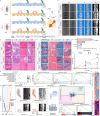Self-powered triboelectric-responsive microneedles with controllable release of optogenetically engineered extracellular vesicles for intervertebral disc degeneration repair
- PMID: 38982049
- PMCID: PMC11233569
- DOI: 10.1038/s41467-024-50045-1
Self-powered triboelectric-responsive microneedles with controllable release of optogenetically engineered extracellular vesicles for intervertebral disc degeneration repair
Abstract
Excessive exercise is an etiological factor of intervertebral disc degeneration (IVDD). Engineered extracellular vesicles (EVs) exhibit excellent therapeutic potential for disease-modifying treatments. Herein, we fabricate an exercise self-powered triboelectric-responsive microneedle (MN) assay with the sustainable release of optogenetically engineered EVs for IVDD repair. Mechanically, exercise promotes cytosolic DNA sensing-mediated inflammatory activation in senescent nucleus pulposus (NP) cells (the master cell population for IVD homeostasis maintenance), which accelerates IVDD. TREX1 serves as a crucial nuclease, and disassembly of TRAM1-TREX1 complex disrupts the subcellular localization of TREX1, triggering TREX1-dependent genomic DNA damage during NP cell senescence. Optogenetically engineered EVs deliver TRAM1 protein into senescent NP cells, which effectively reconstructs the elimination function of TREX1. Triboelectric nanogenerator (TENG) harvests mechanical energy and triggers the controllable release of engineered EVs. Notably, an optogenetically engineered EV-based targeting treatment strategy is used for the treatment of IVDD, showing promising clinical potential for the treatment of degeneration-associated disorders.
© 2024. The Author(s).
Conflict of interest statement
The authors declare no competing interests.
Figures






References
-
- Knezevic, N. N., Candido, K. D., Vlaeyen, J. W. S., Van Zundert, J. & Cohen, S. P. Low back pain. Lancet398, 78–92 (2021). - PubMed
-
- Hartvigsen, J. et al. What low back pain is and why we need to pay attention. Lancet391, 2356–2367 (2018). - PubMed
-
- Francisco, V. et al. A new immunometabolic perspective of intervertebral disc degeneration. Nat. Rev. Rheumatol.18, 47–60 (2022). - PubMed
-
- Andersson, G. B. Epidemiological features of chronic low-back pain. Lancet354, 581–585 (1999). - PubMed
MeSH terms
Substances
Grants and funding
LinkOut - more resources
Full Text Sources
Molecular Biology Databases
Miscellaneous

